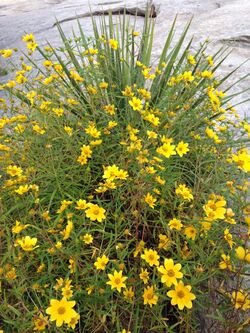Biology:Helianthus porteri
| Porter's sunflower, also known as Stone Mountain or Confederate daisy | |
|---|---|

| |
| Helianthus porteri on Stone Mtn. | |
| Scientific classification | |
| Kingdom: | Plantae |
| Clade: | Tracheophytes |
| Clade: | Angiosperms |
| Clade: | Eudicots |
| Clade: | Asterids |
| Order: | Asterales |
| Family: | Asteraceae |
| Genus: | Helianthus |
| Species: | H. porteri
|
| Binomial name | |
| Helianthus porteri (A.Gray) Pruski 1998 not (A.Gray) Heiser 1978 (1978 name not validly published)
| |
| Synonyms[1] | |
| |
Helianthus porteri is a species of sunflower known by the common names Porter's sunflower,[2] Stone Mountain daisy[3] and Confederate daisy. The term "daisy" is imprecise because the species is a sunflower (Helianthus) rather than a daisy (Bellis and related genera). Likewise, although the plant grows on Stone Mountain, GA, its range extends well beyond. The connection to the Confederacy is through Stone Mountain which contains a confederate monument, although the connection is tenuous as the species was named before the Civil War in 1849 by Harvard botanist Asa Gray in honor of Thomas Conrad Porter, a Pennsylvanian minister and botanist who collected the plant in Georgia.[4] Gray initially named the plant Rudbeckia porteri,[5] later changed to Helianthus in 1998 by John F. Pruski.[6]
The species is native to the southeastern United States, including Alabama and Georgia, but has been introduced to granite outcrop areas in North Carolina as an aggressive weed.[7][8] Helianthus porteri grows on thin soils on and around flat rock granite and gneiss outcrops.[9] It is an annual herb up to 100 cm (40 inches) tall. One plant usually produces 5 or more flower heads, each containing 7 or 8 yellow ray florets surrounding 30 or more yellow disc florets.[10][11]
References
- ↑ The Plant List, Helianthus porteri (A.Gray) Pruski
- ↑ "Helianthus porteri". Natural Resources Conservation Service PLANTS Database. USDA. https://plants.usda.gov/core/profile?symbol=HEPO3. Retrieved 6 July 2015.
- ↑ Scott Ranger's Nature Notes http://scottranger.com/helianthus-porteri-confederate-daisy.html
- ↑ Heller, A. A. (1901). "Thomas Conrad Porter". The Plant World 4 (7): 130–131. ISSN 0096-8307.
- ↑ "Rudbeckia porteri in Global Plants on JSTOR". https://plants.jstor.org/compilation/Rudbeckia.porteri.
- ↑ Pruski, John F. (1998). "Helianthus porteri (A. Gray) Pruski (Compositae), a New Combination Validated for the Confederate Daisy". Castanea 63 (1): 74–75. ISSN 0008-7475. https://www.jstor.org/stable/4034058.
- ↑ Biota of North America Program 2014 county distribution map
- ↑ Weakley AS. 2015. Flora of the southern and mid‐Atlantic states. University of North Carolina Herbarium, North Carolina Botanical Garden, Chapel Hill, NC, USA. [WWW document] URL http://www.herbarium.unc.edu/flora.htm
- ↑ Scott Ranger's Nature Notes http://scottranger.com/helianthus-porteri-confederate-daisy.html
- ↑ Flora of North America, Helianthus porteri (A. Gray) Pruski, 1998. Confederate daisy
- ↑ Blake, Sydney Fay 1918. Contributions from the Gray Herbarium of Harvard University 54: 114–115, as Viguiera porteri
External links
- photo of herbarium specimen at Missouri Botanical Garden, collected in Georgia in 1846, isotype of Rudbeckia porteri/Viguiera porteri/Helianthus porteri
- Scott D. Gevaert, Jennifer R. Mandel, John M. Burke, and Lisa A. Donovan. 2013. High Genetic Diversity and Low Population Structure in Porter’s Sunflower (Helianthus porteri). Journal of Heredity 2013:104(3):407–415[|permanent dead link|dead link}}] doi:10.1093/jhered/est009
- Plant Life of the Monastery of the Holy Spirit by Jim Allison
- Alabama Plant Atlas, Helianthus porteri
Wikidata ☰ Q15485323 entry
 |

